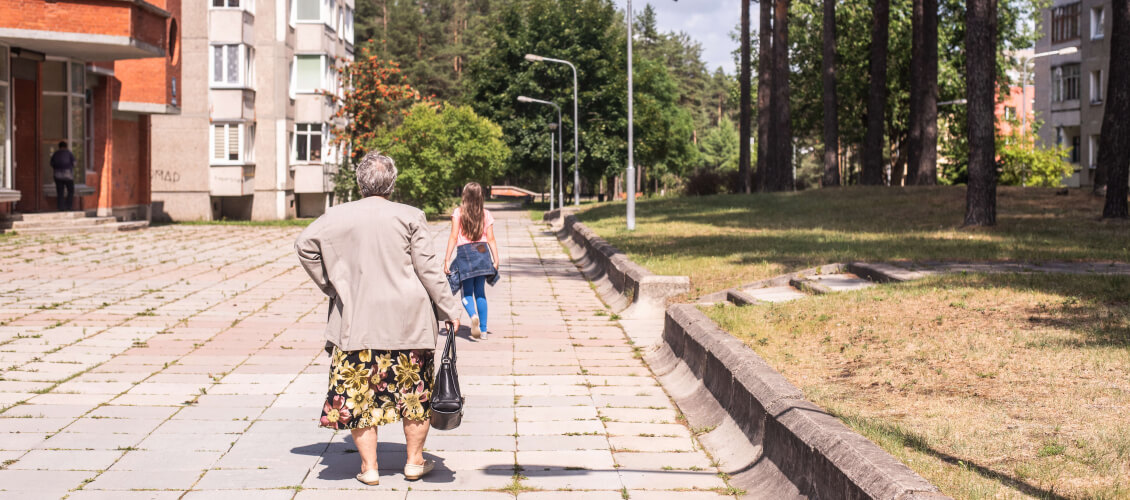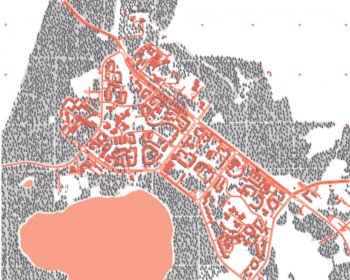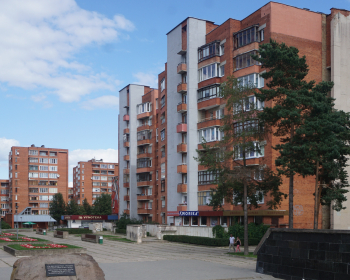Situated among pine forests a two-hour train ride away from Lithuania’s capital Vilnius, the town of Sniečkus (renamed Visaginas after Lithuania became independent of the Soviet Union in 1991) was founded in 1975 to accommodate nuclear power station workers. Highly qualified engineers and nuclear physicists came from all over the USSR and the then-socialist countries to work on the construction, and later the operation of, the Ignalina Nuclear Power Plant. At the time it was built, the plant was the world’s most powerful, providing 70 percent of Lithuania’s electricity. Intended as a display of Soviet progress to the West, Sniečkus became the home of a Russian-speaking, multicultural society.
Its inhabitants, hailing from more than 40 countries, lived an isolated yet privileged life. During its ‘golden age’ in the mid-1980s, with one active reactor and two more in construction, more than 13,500 people worked at the plant. At the time, Visaginas was home to the best schools, public infrastructure, and facilities that the USSR could offer. The town on the shores of Lake Visaginas provided a high quality of life to its young, diverse, and highly educated population. As its urban layout was originally designed to resemble the shape of a butterfly, the residents began to refer to their hometown lovingly as the “Butterfly City”. Another expression of the optimistic spirit of the town’s founding years is the name of its first street: Vilties gatvė (“Hope Street”).
An Identity Crisis for Visaginas
When walking down Vilties gatvė today, a sense of melancholia seems to have replaced the hope once invested in these streets. A lot has changed for the town since the fall of the USSR in 1991. After its independence, the cash-strapped country of Lithuania sought to join the European Union. One of the key conditions for its accession was the dismantling of the Ignalina plant due to safety concerns: its reactors were of the same type, but three times as powerful, as the RBMK reactors in the infamous Chernobyl plant.
When the plant completely stopped its energy production in 2009, at one stroke the town lost its main source of energy, income, and employment. Ten years later, a third of the population, mostly young people, have migrated to Russia and other countries in Europe. What remains of Visaginas is a town with abandoned homes and a population of about 18,700 people with an average age of 55. A place without much hope for the future.
As a mostly Russian-speaking town (more than half of the population is Russian) situated in the north-eastern corner of Lithuania, many residents feel disconnected from the rest of the country and the European Union. Since the decommissioning of the power plant, Visaginas has found itself in the midst of an existential crisis. As Visaginas was built for the express purpose of serving the power plant, it seems fair to ask whether the town also lost its identity and hence its future on the day that the plant closed?
Mid-August 2019: Exploring Post-Nuclear Urbanism
This was the question running through my head when my train pulled up in the middle of a deep forest. I jumped down from the carriage, helped by the weight of the backpack pressing on my shoulders. As the only foreigners on the Soviet-era train, it turned out not to be that hard to find the other summer school participants. As soon as we had left Vilnius, we traveled for two hours through a landscape of seemingly infinite pine forests and innumerable lakes.
By the time I arrived at the modest train station of Visaginas, I found myself amongst a motley crew of ten venturesome students from all over Europe – later joined by two young Visaginians. We all came from very different backgrounds and contexts, but we shared a strong fascination for Soviet (socialist) urbanism and architecture. Another commonality was our decision to apply for the “Post-Nuclear Urbanism Summer School”, a workshop organized by the Laboratory of Critical Urbanism (LCU) at the European Humanities University in Vilnius.
During the summer school, we participants stayed at a Soviet-era hotel located next to the former training center of the nuclear power plant. Featuring an exact copy of the plant’s control room, the center was built to train the operators of the Ignalina plant. This hotel was our base for further explorations of the unique urban features of Visaginas. The town is the result of top-down Soviet planning practices, a nuclear legacy, and a mono-functional purpose. Engaging with the topics of urbanity, technology, and knowledge infrastructures, we did extensive fieldwork within Visaginas and conducted interviews with representatives of local government, public and private institutions and power plant personnel, as well as with engaged community members.
Throughout the project, a team of tutors provided us with inspiration and guidance, assisting us with drafting a final proposal addressing the current and future challenges of Visaginas. This year’s tutors included sociologists and organizers Siarhei Liubimau and Dasha Pyrogova (European Humanities University) as well as architecture lecturers Jan Kristek, Radek Toman (Brno University of Technology, Czech Republic), and Anthony Roberts (University of Brighton, UK). In addition, we followed a module of lectures on Soviet nuclear towns as a particular mode of urbanization, alongside modules on changing institutional arrangements in post-socialist countries and the design of libraries as knowledge infrastructures. Several guest speakers from the Visaginas region, Vilnius, and also neighboring Poland joined us over the course of the summer school.
While the academic program offered many interesting insights, I will particularly remember the group spirit. As the days passed, my world seemed to shrink to the size of the town. As a collective of young people with a similar interest in urban studies, kindled by our experiences in Visaginas, our motley crew became a group of friends. We spent the evenings together exploring the town’s streets and its surrounding nature. We met up with the local youth, either at the only bar (including bowling alleys) in town or at informal parties deep in the forests. The next morning, we would go for a swim in one of the serene lakes. We were also invited to compete in the yearly dragon boat race on Lake Visaginas. Despite a training session led by former Olympic medallist and local sports hero Jevgenij Shuklin, we managed to nearly sink our boat to the bottom of the lake – much to the delight of the locals standing on the shore gloating.
Putting Visaginas back on the map
The summer school was organized within the framework of plans to build a new public library. The new building is perceived by local politicians and a group of major stakeholders as an opportunity to dismantle the hermetic, tenacious relationship between the town and the power plant.
Through conducting fieldwork and collecting ideas and stories from residents of Visaginas, we worked to come up with a proposal for how new, town-oriented governance and economic activities could be strengthened in the years to come: a future in which the power plant will become less central, both in providing a purpose and identity to life in the town, as well as for the town’s relations to the outside.
We observed that local politicians, involved community members and entrepreneurs are engaged with this question of how to move the town away from its nuclear identity. Their proposals are also aimed at developing other economic activities that can put an end to outmigration and attract visitors, and potentially new residents. Hence, very few people seem unaware of the current challenges and identity questions which Visaginas is currently facing. However, different stakeholders have different, and in some cases opposing, ideas as to what could put the forgotten Soviet-era nuclear town back on the map.
Chernobyl Tourism
The pictures of Visaginas might look familiar to anyone who has watched the HBO Chernobyl series, as it was the power plant here that served as a major filming location. The immensely popular series, watched by over 8 million people, portrayed the catastrophic nuclear explosion at the Chernobyl nuclear power plant near the town of Pripyat in Ukraine in 1986. Since the series was released in May 2019, tourism to the plant in Visaginas has increased massively.
This is partly because, more than 30 years on, Chernobyl’s radiation levels remain too high for tourists to walk around the plant. Thousands of tourists from all over the world have poured into the Ignalina Power Plant for the unique experience of being able to walk on nuclear reactors: something that is still too dangerous to do in Chernobyl. The power plant administration in Visaginas is now planning to invest in a visitor center, which is to provide information on the operation and dismantling of the plant.
Visaginas as the Silicon Valley of the Baltics
Another potential area for economic development is a new factory that is currently being built in Visaginas by a UK-based medical equipment firm. Opening its doors this year, the factory is expected to give an economic boost to the town, by initially employing about 200 people, a number which could eventually increase to a workforce of 1,500. Some local politicians and entrepreneurs envision the future of Visaginas as an IT hub. In this scenario, the former nuclear facilities are to be transformed into data centers. They hope to attract firms to the new Silicon Valley of the Baltics by introducing a free economic zone, an area where companies are taxed very lightly, or by offering tax concessions.
Ecotourism
While many Lithuanians might not be able to pinpoint Visaginas’ location on the map, the region around it is widely known for its natural beauty. The town is named after Lake Visaginas and borders the country’s largest lake, Lake Drūkšiai. Local support for promoting the town as an ecotourism destination is growing, and locally-based travel agencies witness an increase in bookings for trips around neighboring lakes and forests.
Cultural institutions
In terms of the cultural landscape, Visaginas constitutes an interesting case for studying bottom-up initiatives. These initiatives have started to emerge in recent years as alternatives and replacements for existing formal institutions such as public libraries, which are seeing their visitor numbers decline. An example of one of these bottom-up initiatives is “Tochka” (“The Point”) led by Alex Urazov. After four years of living in the UK, Alex moved back to his hometown to set up an art residency, which occupies a 5-story building in the center of town. Tochka welcomes young Visaginas residents and visiting artists, in an environment where they are invited to do crafts, draw on the walls, engage in heated debates about any topic or read books. Another such project is “Atmosfera”, which also aims to provide a space for young Visaginians to play, debate and create. Through their activities, these institutions take up tasks that were formerly performed by local librarians, after-school day-care, or even social workers.
COMING SOON: A Pavilion for Public Participation
As the aim of the summer school was to work towards a final proposal, we organized a public intervention on the last day of our stay. The idea of a new public library has been a topic by the local public and political agenda for a number of years. We, therefore, built on this idea to organize a day-long public intervention at a central location in Visaginas. At this site, which is a possible location for the reconstruction of the library, we opened the COMING SOON pavilion. COMING SOON was designed to express sensitivity to the existing context of the knowledge-related practices of the local population and organizations, as well as to residents’ expectations for a new public institution in their town.
In this pop-up pavilion, residents were invited to participate in the programming and design process of a future library building. The citizen participation methods we proposed included: a survey, two focus group interviews with local freelancers and cultural actors, participatory mapping, an engagement tool to address Visaginas’ diaspora abroad and a soundscape installation. Hence, COMING SOON provided residents with a platform to engage in local urban governance, as well as a place where different actors in the town could interact. The pavilion was projected to especially empower actors that were not yet included in the discussions over the development of a future public library, such as informal cultural initiatives, self-employed people and children.
Ultimately, COMING SOON brought together the concept of an urban laboratory, a citizen participation initiative and a presentation of how the Visaginas public library could be projected to meet the needs of the town in its current phase of transformation.
To get an impression of our public intervention, watch the video below that I produced in collaboration with summer school participant and cinematographer Adrian Pedrazas Profumo. The video was released as part of the “Happy Summer Happy City” campaign by Rotterdam-based urban agency BRAND.
Daydreaming in Visaginas
It is hard, maybe even impossible, to put my summer in a remote post-Soviet nuclear town into words. In an attempt to give an impression of my experiences, I have included some of the pictures which were taken throughout the summer school, by myself and fellow summer school participants.
Reflecting on my time in Visaginas, I believe that these photographs – despite their beauty – do not do justice to the town and its people. In contrast to how it might appear in pictures, the town’s atmosphere is not apocalyptic or desperate. Life in this post-nuclear town rather felt daydreamy, as though it has been frozen in time. I would highly recommend experiencing the unique context of Visaginas for yourself, as it makes a fascinating case for anyone who is interested in Soviet-, post-socialist or mono-industrial cities, and essentially, in urban studies in general.
Faced with the challenge to reinvent its purpose and identity, Visaginas finds itself on the verge of a period of major transition. The first generation of inhabitants gave birth to the town by erecting it themselves. Their children might be witnesses to its death or, let us rather hope, play a critical role in the resurrection of Visaginas.
Curious to experience Visaginas yourself?
The Laboratory of Critical Urbanism is currently working on a new summer school to be organized in the summer of 2020. Please contact the organizer Assoc. Prof. Siarhei Liubimau for more information via siarhei.liubimau@ehu.lt. The author of this article, Job Zomerplaag, can be contacted via job.zomerplaag@gmail.com.
Please find some further reading and film recommendations on Visaginas below:
- “Butterfly City”, 2017 documentary about Visaginas by Olga Černovaitė.
- “HBO’s Chernobyl Has Led to a Surge in Tourism for This Forgotten Nuclear Town. Now, It’s Trying to Redefine Itself”, Time Magazine (December 27, 2019).
- “Visaginas: Understanding the post-soviet city. Purpose and belonging in a former nuclear town in Lithuania”, written by summer school organizer Siarhei Liubimau for Actors of Urban Change (December 4, 2018).
- “Decommissioned places: Ruins, endurance and care at the end of the first nuclear age”, journal publication by Leila Dawney (2019).
- “In a Soviet-era nuclear town, I brought Lithuania’s forgotten side to light”, Opinion-piece in The Guardian by Neringa Rekašiūtė (June 12, 2019).
- “Life in the Atomic City of Visaginas”, part of the Beyond91 series by Are We Europe and Café Babel.
- “Visaginas and Chernobyl are inseparably linked’ – Lithuanian nuclear town sees future in tourism and industry” , LRT (August 13, 2019).



